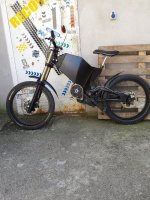ElectricGod
10 MW
notger said:LightningRods said:62 rpm/volt for the Big Block
67 rpm/volt for the Small Block
since one week I'm owner of an adaptto, an just tried it with my gng-mutant.
The adaptto has a feature called "autodetect" and it "detects" my orignial GNG to be 55 KV ?
might adaptto detect wrong, or did anyone of you ever check the KV of the LR or GNG Motors?
is there actually a Motor diagramm about this kind of motor somewhere around ?
Cause i just recently did some changes on my kit, and tried to calculate the cadence beforehand.
I'm still using bike chains in the secondary stage and 60Volt.
luckiely reality beatet mathematics and the calculated cadence of 245 rpm and 104km/h was not reality.
so i guess without diagramm and knowing the motors most efficient "zones" i can not make any realistic calculations.
But those calculations were made with 67 KV, who knows it might be 55, like adaptto "autodetected"
I like reality best. Any engineer will tell you that things rarely work out exactly like the "specs". I suggest hooking up the motor to a drill and using a tacho and DMM to find your Kv.




